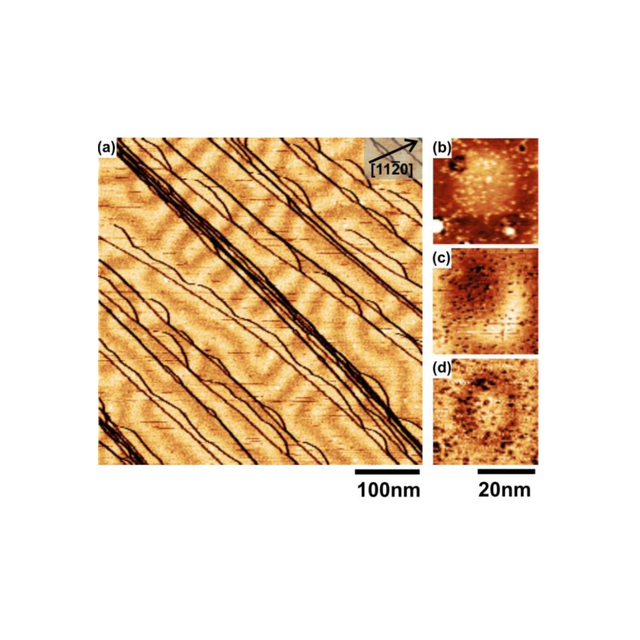
Seminars

Spin resolved scanning tunneling microscopy: Non-collinear magnetism and high frequency dynamic properties
C2N - Site Marcoussis, C2N site Marcoussis, salle D1-132, MarcoussisSeminars
In magnetic thin films the Heisenberg exchange interaction often leads to a parallel or antiparallel alignment of neighboring spins in the crystal. When inversion symmetry is broken e.g. by a surface or an interface, the non-collinear Dzyaloshinskii-Moriya interaction competes with the Heisenberg exchange interaction. This competition can lead, in some case, to the stabilization of complex spin textures such as spin spirals or skyrmions. Investigation of the local dynamic properties of magnetic structures - such as skyrmion or nano-skyrmionic lattice - require the implementation of experimental technique with a high spatio-temporal resolution (nm and sub-ns resolution). In this talk, I will first show that spin-polarized STM (SP-STM) is an ideal tool to probe such non-collinear magnetic structure. The characterization of spin spirals and skyrmions state in an ultra-thin Co layer will be presented (fig. 1). In a second part I will explain our current progress in the development of a new experimental technique combining ferromagnetic resonance (FMR) with SP-STM.

Topological pumps and topological quasicrystals
C2N - Site Marcoussis, C2N site Marcoussis, MarcoussisSeminars
Topological phases of matter have fascinated researchers since over 30 years. Indeed, last year's Nobel prize joins the previous two awards for the quantum Hall effect in commending this unique field. In my talk, I will start with the quantum Hall effect and demonstrate how it is related to topological pumps. Using Laughlin's argument, we shall see how such pumps are best understood in the context of time-dependent electronic (fermionic) systems. I will, then, present our realizations of topological pumps using two completely different bosonic systems,
namely, using coupled photonic waveguide arrays and with trapped atoms in optical superlattices. In the second part of my talk, I will detail the connection between quasicrystals and topological pumps. In this context, we have found that quasicrystals inherit topological attributes
from their corresponding pumps, i.e., quasicrystals are characterized with topological indices from dimensions higher than their own. I will discuss several 1D quasi-periodic models with nontrivial 1st Chern numbers and topological boundary states, which are inherited from the 2D quantum Hall effect. This topological classification leads to several interesting physical implications. Last, I will present how this naturally leads to realizing the 4D quantum Hall effect and 2D topological pumps in the lab.

Topological Spintronics: from the Haldane phase to spin devices
C2N - Site Marcoussis, C2N site Marcoussis, salle R. Planel, MarcoussisSeminars
We provide a perspective on the recent emergence of “topological spintronics,” which relies on helical Dirac electrons on the surfaces of solids with strong spin-orbit coupling [1]..When time- reversal symmetry is broken by ferromagnetic order, the helical Dirac states transition to chiral edge states [2]. This is a realization of Haldane’s Chern insulator phase of matter, characterized by a precisely quantized Hall conductance and ballistic edge transport without a magnetic field, even in systems with significant electronic and magnetic disorder [3,4]. The interplay between these edge states, dissipative channels and magnetic order appears to yield a condensed matter realization of quantum tunneling out of a ‘false vacuum’ [4]. Interesting opportunities are also emerging for patterning and manipulating the edge states using optical techniques [5]. On a more pragmatic note, the helical spin texture of the surface states also leads to efficient spin- charge conversion at room temperature [6,7], allowing one to envision novel devices for universal memory and spin-based logic.
[1] M. Neupane, A. Richardella et al., Nature Communications 5, 3841 (2014). [2] A. Kandala, A. Richardella, et al., Nature Communications 6, 7434 (2015). [3] E. Lachman et al., Science Advances 1, e1500740 (2015).
[4] M. Liu et al., Science Advances 2, e1600167 (2016).
[5] A. L. Yeats et al. PNAS (online 12 September, 2017).
[6] A. Mellnik, J. S. Lee, A. Richardella et al., Nature 511, 449 (2014). [7] H. Wang et al., Physical Review Letters 117, 076601 (2016).

Nanoscale contact as a source of plasmons for plasmonic nanocircuits
C2N -Site Orsay, C2N-Site orsay, Orsay CedexSeminars
Electrically driven optical antennas are attracting much attention, in particular, due to necessity to develop integrated electrical source of surface plasmons for future plasmonic nanocircuitries. By default, this term denotes a metal nanostructure, in which electromagnetic oscillations at optical frequencies are excited by electrons, tunneling between metallic parts of the structure when a bias voltage is applied between them.
Instead of relying on an inefficient inelastic light emission in a tunnel gap, we are suggesting to use ballistic nanoconstrictions as the feed element of an optical antennas in order to excite electromagnetic plasmonic modes. Similarly to tunneling structures, the voltage applied at the constriction falls over the contact of nanoscale length. Electron passing through the contact ballistically can gain the energy provided by the bias ~1eV and exchange it into an mode of the optical antenna. We discussed the underlying mechanisms responsible for the optical emission, and show that with nanoscale contact, one can reach quantum efficiency orders of magnitude larger than with standard tunneling structures.

Ultrafast and Very Small: Discover Nanoscale Magnetism With Picosecond Time Resolution Using X-Rays
C2N -Site Orsay, C2N-Site orsay, Orsay CedexSeminars
Today’s magnetic device technology is based on complex magnetic alloys or multilayers that are patterned at the nanoscale and operate at gigahertz frequencies. To better understand the behavior of such devices one needs an experimental approach that is capable of detecting magnetization with nanometer and picosecond sensitivity. In addition, since devices contain different magnetic elements, a technique is needed that provides element-specific information about not only ferromagnetic but antiferromagnetic materials as well. Synchrotron based X-ray microscopy provides exactly these capabilities because a synchrotron produces tunable and fully polarized X-rays with energies between several tens of electron volts up to tens of kiloelectron volts. The interaction of tunable X- rays with matter is element-specific, allowing us to separately address different elements in a device. The polarization dependence or dichroism of the X-ray interaction provides a path to measure a ferromagnetic moment and its orientation or determine the orientation of the spin axis in an antiferromagnet. The wavelength of X-rays is on the order of nanometers, which enables microscopy with nanometer spatial resolution. And finally, a synchrotron is a pulsed X-ray source, with a pulse length of tens of picoseconds, which enables us to study magnetization dynamics with a time resolution given by the X-ray pulse length in a pump-probe fashion.
The goal of this talk is to present an introduction to the field and explain the capabilities of synchrotron based X-ray microscopy, which is becoming a tool available at every synchrotron, to a diverse audience. The general introduction will be followed by a set of examples, depending on the audience, that may include properties of magnetic materials in rocks and meteorites, magnetic inclusions in magnetic oxides, interfacial magnetism in magnetic multilayers, and dynamics of nanostructured devices due to field and current pulses and microwave excitations.

Characterization and applications of passively mode-locked semiconductor lasers
C2N -Site Orsay, C2N-Site orsay, Orsay CedexSeminars
Passively mode-locked semiconductor lasers are multimode lasers able to generate short pulses (~2ps) at a repetition rate of 40 GHz even though they are dc biased. In the first part of this presentation an overview of mode-locking techniques will be given, and then some applications and results lasers will be showed.

Nano-optomechanics with hybrid carbon nanotube resonators
C2N - Site Marcoussis, C2N site Marcoussis, salle R. Planel, MarcoussisSeminars
Optomechanical research have recently achieved important progress, notably with the first evidence of quantum behaviours on solid-state mechanical devices, including the demonstration of quantum backaction noise in interferometric systems and the preparation of mechanical resonators close to the quantum ground state. One of the major contribution to these milestones relies on the miniaturization of mechanical resonators at the nanoscale, enabling strongly decreased sensitivity towards classical decoherence mechanisms. The technological challenge raised is therefore to secure strong optomechanical interaction at that scale without compromising mechanical properties.
I will present a novel experimental approach, enabling unprecedentedly low level of thermal decoherence at room temperature. The concept relies on a carbon nanotube resonator at the tip of which an efficient nano-optical scatterer is synthesized. I will show that highly sensitive detection of such system is granted at very low power, and that dynamical backaction control of its vibrational state is available even without the assistance of cavity optical confinement. The mechanical frequency noise will also be analysed as a function of the vibrational state, opening the way towards quantitative understanding of mechanical decoherence in carbon nanotubes at room temperature. I will then conclude upon perspectives to incorporate the system into a cavity optomechanical design.

Electromagnetic metasurfaces: Physics and applications
C2N -Site Orsay, C2N-Site orsay, Orsay CedexSeminars
Metasurfaces are ultra-thin metamaterials composed by artificial planar meta-atoms arranged in some specific macroscopic orders, which exhibit extraordinary capabilities to control electromagnetic (EM) waves. In this talk, we briefly summarize our latest experimental results on employing metasurfaces to control electromagnetic waves. Specifically, we will show how to realize a photonic spin-Hall effect with nearly 100% efficiencyin both reflection [1] and transmission [2] geometries, how to achieve surface-plasmon couplers that can excite surface plasmon polaritons (SPPs) very efficiently [3,4], and how to actively control the phases of electromagnetic waves in THz [5] and GHz regimes [6], based on a compete phase diagram for metal/insulator/metal metasurface [7].
References
[1] Weijie Luo, et al.,, Adv. Opt. Mater. 3, 1102 (2015).
[2] Weijie Luo, et al., Phys. Rev. Appl. 7, 044033 (2017).
[3] Wujiong Sun, et al., Light: Science & Applications 5, 16003 (2016).
[4] Jingwen Duan, et al., Sci. Rep. 7 1354 (2017).
[5] Ziqi Miao, et al, Phys. Rev. X 5, 041027 (2015).
[6] Hexiu Xu, el al., Sci. Rep. 6 27503 (2016); Sci. Rep. 6 38255 (2016); Appl. Phys. Lett. 109, 193506 (2016)
[7] Che Qu, Shaojie Ma, et al., Phys. Rev. Lett. 115, 235503 (2015).

Recurrences in an one-dimensional Bose gas
C2N - Site Marcoussis, Salle D2-106 Mezzanine, MarcoussisSeminars
Even though the evolution of an isolated quantum system is unitary and should therefore be intrinsically periodic, the complexity of interacting many-body systems prevents the observation of recurrences of quantum states for all but the smallest systems. For large systems the full quantum states are not accessible and the requirements to observe a recurrence in experiments reduces to being close to the initial state with respect to the employed observable. Selecting an observable connected to the collective excitations in a pair one-dimensional superfluids realized with ultracold rubidium atoms, we demonstrate recurrences of coherence and long range order in an interacting many-body system containing thousands of particles. This opens up a new window into the long time dynamics of large quantum systems even after they reached a transient thermal-like state.

On-chip wireless optical communication through plasmonic nanoantennas
C2N -Site Orsay, C2n -site Orsay, Orsay CedexSeminars
On-chip wireless optical communications among distant cores in chip multiprocessors can lead to a completely new approach to the limits of current on-chip communication. In fact, using wireless connections mitigates the problems related to the design and the fabrication of hugely complex switching fabrics, where long paths suffer of crosstalk and loss issues. Implementing wireless communication at optical frequencies allows simplifications in network fabrication and management. In this presentation, an overview of our recent research on plasmonic nanoantennas for wireless optical networks-on-chip will be proposed. In particular, the design and optimization of plasmonic antennas integrated with silicon waveguides will be presented. Moreover, the on-chip wireless propagation characteristics and the point-to-point link performances will be proposed.